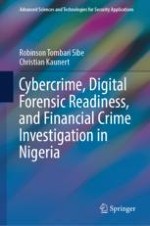
2024 | OriginalPaper | Buchkapitel
1. Background and Introduction
verfasst von : Robinson Tombari Sibe, Christian Kaunert
Erschienen in: Cybercrime, Digital Forensic Readiness, and Financial Crime Investigation in Nigeria
Verlag: Springer Nature Switzerland
Aktivieren Sie unsere intelligente Suche, um passende Fachinhalte oder Patente zu finden.
Wählen Sie Textabschnitte aus um mit Künstlicher Intelligenz passenden Patente zu finden. powered by
Markieren Sie Textabschnitte, um KI-gestützt weitere passende Inhalte zu finden. powered by